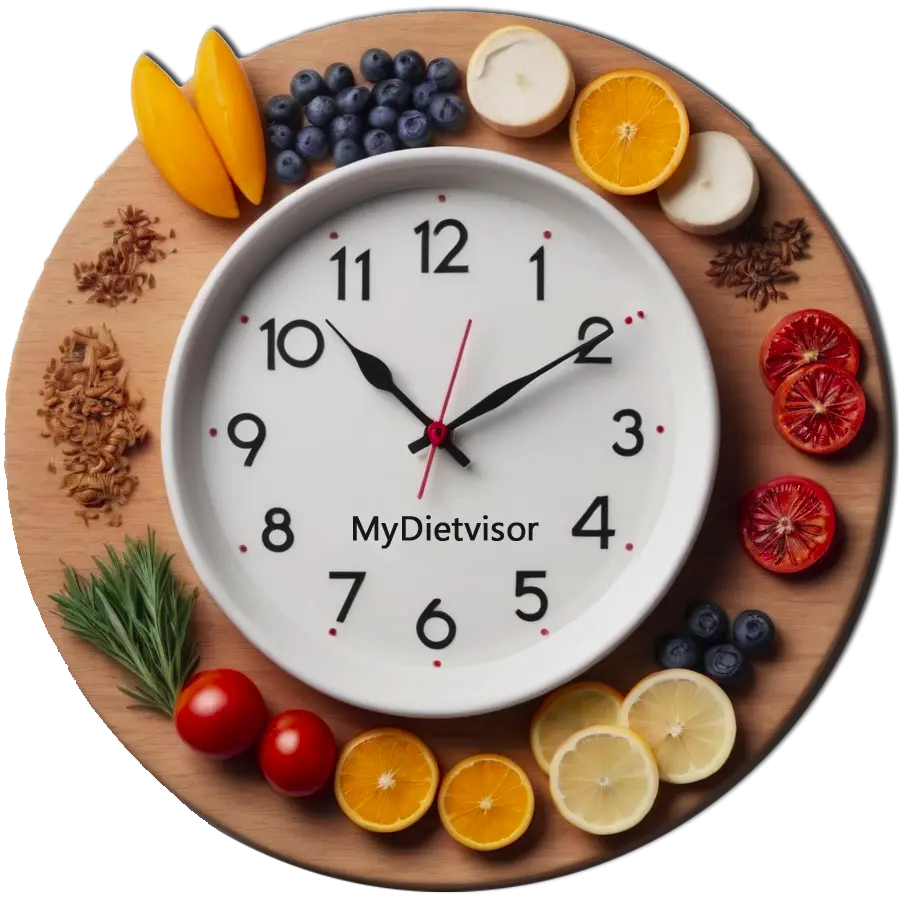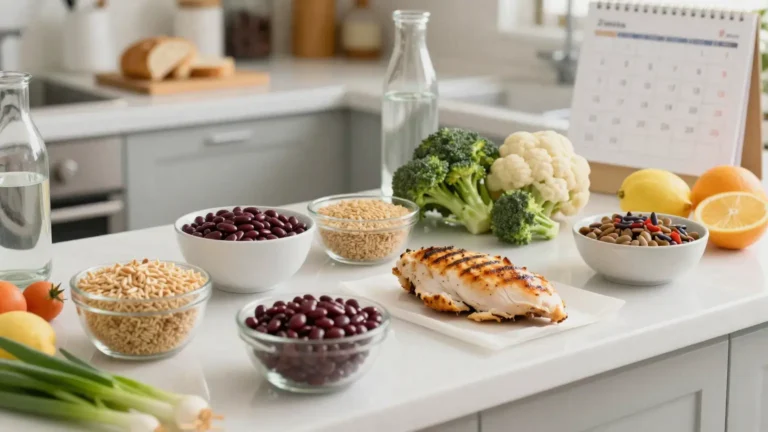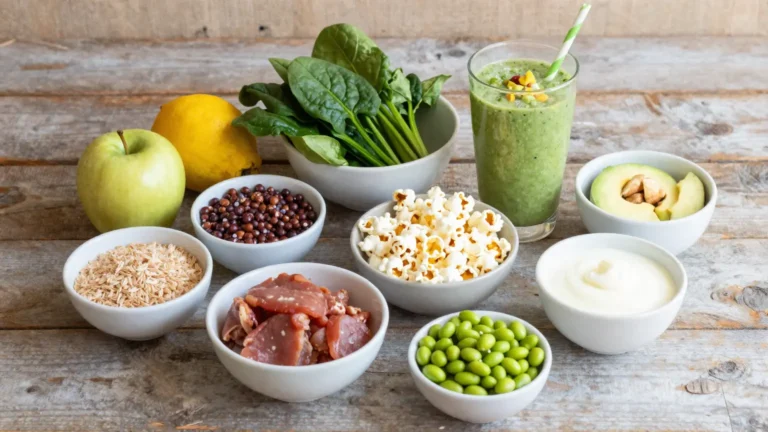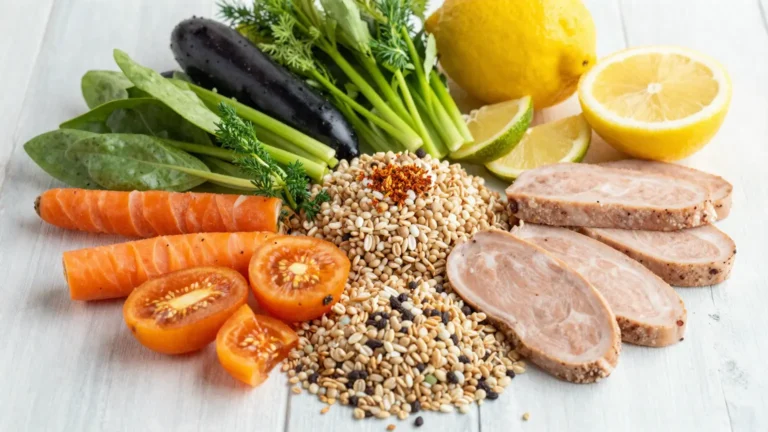The Ketogenic (Keto) Diet and the Atkins Diet are two popular low-carb diets known for their effectiveness in promoting weight loss and improving overall health. Both plans restrict carbohydrate intake to facilitate a state of ketosis, where the body burns fat for energy instead of glucose. However, they differ in approach, phases, and macronutrient breakdown. This comprehensive comparison of Keto vs Atkins diet will help you understand the similarities and differences between these two diets, enabling you to make an informed decision about which one might be best suited for your personal goals and preferences.
Keto vs Atkins Diet Basics
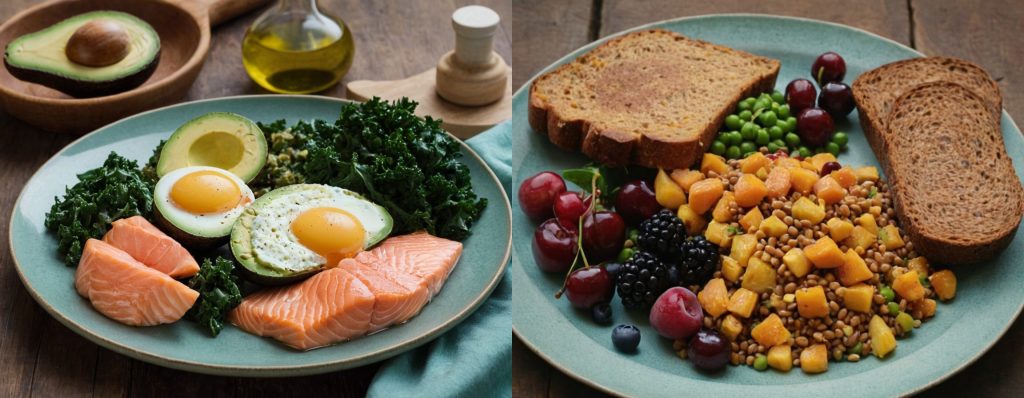
- Ketogenic Diet :
- Introduced by Dr. Russell Wilder in the 1920s as a treatment for epilepsy.
- A high-fat, moderate-protein, very-low-carb diet designed to induce ketosis.
- Typically consists of around 70-80% fat, 20-25% protein, and 5-10% carbs.
- Focuses on maintaining a low carb intake (<20-30g net carbs per day) consistently for weight loss and health benefits.
- Atkins Diet :
- Created by Dr. Robert C. Atkins in the late 1960s as a weight loss solution.
- A low-carb, high-protein and -fat diet divided into four phases: Induction (Phase 1), Balancing (Phase 2), Pre-Maintenance (Phase 3), and Lifetime Maintenance (Phase 4).
- Each phase has varying carb limits and focuses on gradually reintroducing healthy carbs while maintaining weight loss progress.
Keto and Atkins Diet Phases/Structure
Ketogenic Diet:
As a single-phase diet, the Keto Diet maintains consistent macronutrient ratios throughout. There are no distinct phases like the Atkins Diet, but some variations allow for cycling between higher-carb and lower-carb periods to accommodate individual preferences or address potential nutrient deficiencies.
Atkins Diet :
- Induction (Phase 1) :
- lasts 2 weeks
- limits carbs to less than 20g net carbs per day (~90% fat, ~10% protein)
- focuses on reducing insulin levels and encouraging the body to burn fat for energy
- Balancing (Phase 2) :
- begins after the first two weeks of Induction
- gradually adds back healthy fats, proteins, and carbs (~74% fat, ~19% protein)
- increases net carb intake to 25-30g per day while maintaining weight loss progress
- Pre-Maintenance (Phase 3) :
- continues increasing carb intake as weight loss goals are achieved (~63% fat, ~28% protein)
- expands food choices and allows for occasional treats (~45-50g net carbs per day)
- Lifetime Maintenance (Phase 4) :
- focuses on maintaining a healthy weight long-term
- encourages personalized carb intake based on individual tolerance and goals (~36% fat, ~43% protein, ~21% carbs)
Keto vs Atkins Diet Macronutrient Breakdown
| Keto Diet (% of calories) | Atkins Diet (% of calories) | |
|---|---|---|
| Fat | 70-80 (Highest ratio among macronutrients) | ~90 (Induction), ~74 (Balancing), ~63 (Pre-Maintenance), ~36 (Lifetime Maintenance) |
| Protein | 20-25 (Moderate intake to support muscle mass and recovery) | ~10 (Induction), ~19 (Balancing), ~28 (Pre-Maintenance), ~43 (Lifetime Maintenance) |
| Carbohydrates | 5-10 (Very-low carb intake to facilitate ketosis; net carbs are typically less than 20-30g per day) | ~0-5 (Induction), ~6 (Balancing), ~9 (Pre-Maintenance), ~21 (Lifetime Maintenance) |
Allowed Foods for Keto vs Atkins Diet
Both diets emphasize whole, nutrient-rich foods while limiting processed carbohydrates and sugars. However, the specific allowed foods may vary slightly between the two plans due to their different approaches.
Here are food lists for both the Ketogenic (Keto) Diet and the Atkins Diet. While there are some similarities between these low-carb diets, the Atkins Diet allows for a broader range of foods, particularly as you progress through its phases.
Ketogenic (Keto) Diet Food List:
- Meats :
- Beef (grass-fed if possible)
- Pork
- Lamb
- Poultry (chicken, turkey)
- Fish and seafood (salmon, tuna, shrimp, etc.)
- Eggs :
- Pastured or free-range eggs
- Fatty Plants :
- Avocados
- Olives
- Coconut products (coconut oil, coconut milk, coconut cream)
- Nuts and seeds (in moderation; no peanuts) – almonds, walnuts, chia seeds, flaxseeds, pumpkin seeds
- Low-carb Vegetables :
- Leafy greens (spinach, kale, lettuce, etc.)
- Broccoli
- Cauliflower
- Bell peppers
- Celery
- Zucchini
- Cucumber
- Asparagus
- High-fat Dairy :
- Butter
- Hard and soft cheeses (in moderation)
- Heavy cream
- Greek yogurt (unsweetened, full-fat)
- Oils and Fats :
- Avocado oil
- Olive oil
- Coconut oil
- MCT oil
- Grass-fed butter or ghee
- Sugar-free Beverages :
- Water (with lemon or other citrus juice)
- Tea (black, green, herbal)
- Coffee (unsweetened)
- Sparkling water or mineral water
Atkins Diet Food List:
The Atkins Diet has four phases, with the food list expanding as you progress through each phase. Here’s a general breakdown of allowed foods in each phase:
- Phase : Induction (Indefinitely)
- Meats
- Fatty fish and seafood
- Eggs
- Oils and high-fat dairy (in moderation)
- Low-carb vegetables
- Sugar-free beverages
- Phase 2: Balancing (After losing at least 15 pounds or after 3-6 months)
- All foods allowed in Phase 1, plus:
- Nuts (in moderation; no peanuts)
- Berries (in moderation)
- Melons (in moderation)
- All foods allowed in Phase 1, plus:
- Phase 3: Pre-Maintenance (After losing at least 40 pounds)
- All foods allowed in previous phases, plus:
- Whole-grain products (in moderation)
- Fruits (other than berries and melons; in moderation)
- Starchy vegetables (in moderation)
- All foods allowed in previous phases, plus:
- Phase 4: Lifetime Maintenance
- All foods allowed in previous phases, plus:
- More whole-grain products
- A wider variety of fruits and starchy vegetables
- Occasional indulgences (e.g., a slice of cake at a birthday party)
- All foods allowed in previous phases, plus:
Foods to Avoid on Both Diets :
- High-carb foods :
- Grains (wheat, rice, pasta)
- Sugary fruits (bananas, grapes, pineapple)
- Starchy vegetables (potatoes, corn, sweet potatoes)
- Refined and processed foods :
- Processed meats
- Margarine and shortening
- High-sugar yogurt and ice cream
- Soda, sports drinks, and fruit juices
While the Atkins Diet allows for more food options as you progress through its phases, both diets emphasize whole, unprocessed foods and limit carbohydrates to achieve weight loss and health benefits. Always consult with a healthcare professional before starting any new diet plan.
Pros and Cons of Keto Diet:
Pros :
- Quick weight loss due to reduced appetite and water loss from glycogen depletion
- Improved blood sugar control and insulin sensitivity, beneficial for people with type 2 diabetes or metabolic syndrome
- Enhanced mental clarity and increased energy levels
- May improve symptoms of epilepsy, Parkinson’s disease, and other neurological disorders
Cons :
- Potential short-term side effects like fatigue, headache, foggy brain, nausea, and constipation (“keto flu”)
- Long-term concerns regarding kidney stones and osteoporosis due to high protein intake and potential calcium loss
- Difficulty maintaining social events and eating out due to carb restrictions
Pros and Cons of Atkins Diet:
Pros :
- Effective weight loss while preserving muscle mass due to adequate protein intake
- Gradual reintroduction of healthy carbs allows for flexibility in meal planning and occasional treats
- Reduced cravings and improved satiety from increased fat consumption
- May improve lipid profiles (lower triglycerides, raise HDL cholesterol)
Cons :
- Restrictive Induction phase may cause temporary side effects like bad breath, fatigue, and constipation.
- High protein intake during earlier phases might not be suitable for those with kidney issues due to additional stress on these organs.
- Difficulty adhering to the diet long-term due to its restrictive nature and lack of flexibility in early phases.
Sample Meal Plans for Keto and Atkins Diets
Keto Diet :
Breakfast : Avocado and egg omelet (2 eggs, 1 avocado, 3 tbsp butter) with spinach salad (2 cups)
Lunch : Grilled chicken salad (4 oz chicken breast, 2 cups mixed greens, 2 tbsp olive oil-based dressing) with 1/2 cup blueberries
Dinner : Pan-seared salmon (6 oz) with garlic butter (3 tbsp butter, 1 clove minced garlic) and steamed broccoli (1 cup)
Atkins Diet :
Phase 1 (Induction or Indefinitely) :
Breakfast: Scrambled eggs (2 large) with spinach (2 cups), olive oil, and cheddar cheese (1 oz)
Lunch: Grilled chicken salad – mixed greens (2 cups), grilled chicken breast (4 oz), cherry tomatoes (5), cucumber slices, avocado (1/4 medium), olive oil dressing
Dinner: Baked salmon (6 oz) with a side of steamed broccoli (1 cup)
Phase 2 (Balancing) :
Breakfast : Smoothie: Blend unsweetened almond milk (1 cup), spinach (1 cup), avocado (half a small avocado), and stevia-sweetened protein powder (1 scoop) for a shake
Lunch : Tuna salad (4 oz canned tuna in water, mixed with 2 tbsp mayo, diced celery, red onion, served over greens)
Dinner : Stir-fried chicken thighs (6 oz), broccoli (1 cup), and cauliflower rice (1 cup) cooked in olive oil
Phase 3 (Pre-Maintenance) :
Breakfast: Cottage cheese (1/2 cup) with sliced cucumber (1/2 medium) and cherry tomatoes (5)
Lunch: Chicken Caesar salad – romaine lettuce (2 cups), grilled chicken breast (4 oz), Parmesan cheese (1 tbsp), caesar dressing
Dinner: Baked haddock (6 oz) with a side of steamed quinoa (1/3 cup dry) and sautéed asparagus (1 cup)
Phase 4 (Lifetime Maintenance) :
Breakfast : Scrambled eggs (2 eggs) with spinach (1 cup), mushrooms (1/2 cup), and feta cheese (1 oz)
Lunch : Grilled shrimp skewers (6 oz) with pineapple salsa (1/4 cup), served over mixed greens salad (2 cups) with olive oil-based dressing
Dinner : Baked pork chop (6 oz) seasoned with herbs and spices, served with sautéed green beans (1 cup) and sliced bell peppers (1/2 medium pepper)
Conclusion
Both the Keto Diet and Atkins Diet have their advantages and limitations. The choice between these two high-fat, low-carb diets will depend on your individual goals, preferences, lifestyle, and any underlying health conditions. Consulting with a healthcare professional or registered dietitian can help guide you toward the most appropriate nutrition plan for your needs.
